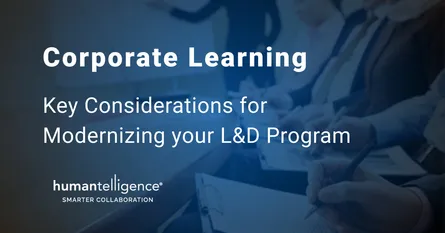
Learning development

The Future of L&D: How AI & Technology Can Improve Talent Development & Support More Employees
- 05 Sep, 2024
- L&D
2025 is just a few months away, so now is the perfect time to start planning what your learning and development programming should look like for employees next year. This might be a hard pill to swallow, but if you’re thinking workshops and consultants, you’re going to miss the mark! Mandatory one-time workshops, expensive external consultants, certifications, and traditional classroom learning are simply dead on arrival. They don’t deliver sustained results. You can’t track them well. They don’t take your learners into consideration. And they’re counter intuitive to today’s need for personalized learning. The amount of people who work remotely at least once per week has grown by 400% since 2010, and as many teams now settle into remote or hybrid work models, a much-needed transformation in traditional learning & development is underway. This shift better supports people in how they now learn today, as reskilling, upskilling, cross training, and internal mobility continue to prove new and up until now, often untapped, sources of power for companies. Research from Lighthouse Research & Advisory shows that 88% of employees said they would stay at a job if they had career and growth opportunities ahead, but more than 60% have left a job in the past because they didn't see any way to advance. In addition, nearly 50% of talent professionals who responded to a LinkedIn survey said they expect their recruiting budget to continue to decrease, while 66% anticipate their L&D budget to increase or stay the same. This suggests employers will continue relying on building their workforce through internal mobility programs tied to reskilling initiatives and/or engage contingent talent instead of hiring externally. In this post, we’ll share suggestions--through the lens of pandemic-driven shifts--for leveraging technology and AI to implement and scale development programs with new ways of learning that aren’t just customized, but that also cross silos and aid in retaining and motivating employees to want to learn more. Yes, technology that improves training efficiency, results, adoption of concepts, and on-going usage within workflows of employees. Key Features of the Modern Corporate Learning Experience Operating a successful business boils down to ensuring your workers are productive, happy, and actively engaged with activities that move the business forward. Chief Learning Officer at Allencomm -- a global learning developer and provider of custom content -- Anna Sargsyan recently told Human Resource Executive: These new demands of hybrid and remote work are tasking us with being much more intentional about learning design. Employee expectations around more human-centered learning are creating a need for more personalization within L&D, while leaders also have to be proactive to help distributed employees learn from one another despite the distance, create innovative approaches to non-classroom learning and ensure learning is accessible everywhere—in different formats and to all employees. In addition to supporting the employee experience, there’s enough evidence now to demonstrate that companies that promote a culture of learning perform better. Take this LinkedIn Learning course (quoting a McKinsey report) that shows companies offering comprehensive training programs have higher income per employee by as much as 200 percent. And for millennials, learning opportunities at a company are now the top metric in their likelihood to stay at a company. A PwC study found the same -- that “the current workforce is more motivated by personal and professional growth than they are by earning more money.” Critical to the success of any L&D program today, new digital tools have dramatically altered how, when and where we learn. Here’s a handful of the key features you should consider when launching or leveling up to a modern corporate learning experience. On-demand learning The brick and mortar professional development course is done. Instead of the rigid classroom model, learning should be part of employees’ daily workflow - at their desks, on their mobile phones, or from wherever they work. They’re much more likely to develop and retain information when they decide on the timing of their training, not when it is dictated by a mass group class. Let’s look at some statistics. Employees who have more control over the learning process and the opportunity to revisit training demonstrate retention rates of up to 60% vs that of 8% for in-person training. In addition, research shows that bite-sized learning makes the transfer of learning from the classroom to the desk 17% more efficient -- encouraging employees to further develop and retain the training, which maximizes effectiveness and value of the training you have delivered. Consumerization of learning Just as apps have changed the way we call cabs or watch movies, new digital learning tools also offer the same intuitive, engaging, and easy-to-use experience for people at work. Agile, cost-effective learning In an era of rapid technological change, learning has become critical for companies to stay up to speed. A modern learning platform accelerates learning program delivery to ensure the most up-to-date training reaches your employees quickly and efficiently. Self-awareness & coaching With a better awareness of team dynamics (aka a team’s culture), L&D leaders are working to understand individuals -- and ultimately creating and delivering programming that leverages a psychometrics-based platform to improve managers’ coaching, increase understanding of their teams, pave a pathway to building a stronger, better-connected team for purposes of more meaningful collaboration -- which leads to increased productivity and strong employee engagement. Consider this:66% of all employees are disengaged (Source: Gallup) 87% of highly engaged employees are less likely to leave (Source: The Muse) Only 25% of employers have an active engagement strategy (Source: The Muse)According to Smarp, companies that do have a high level of employee engagement are more profitable by a factor of 21%. So to more deeply understand what drives the engagement of your people, aside from skill building and growth opportunities, you also need to provide people with a centralized place to both give feedback to others and better understand themselves. Consider employee engagement suites that incorporate self-assessments designed to empower people with a better understanding of their work behaviors, motivators, and work energizers. When investing in engagement solutions, look for a centralized solution that consolidates key feedback-focused areas, such as: Career & development feedback Knowing that coaching and feedback are key to ongoing performance management and engagement, provide an easy way for employees to obtain and manage peer, 360-degree, subordinate and manager feedback more frequently. Pulse survey feedback Pulse your employees on important topics and get instant and consistent feedback to help you make informed operational, policy, programming, or strategy decisions. Be sure you can analyze data by different populations, as well as product, territory, and functional groups. Performance management tracking Use a centralized learning or action management system to track performance and provide actionable content and assignments to help employees track performance, growth, and any new performance management processes. When you have psychometrics behind your AMS -- that is, a clear understanding of what motivates each and every team member and how he or she learns best -- you’re able to further individualize the content and activities, as you align employees around specific strategic goals, tasks, and actions. You can do this by company, by division, by territory, or by function – enabling you to deliver fast, measurable business results. Scalability & sustained results Finally, let’s talk results. How often have your employees come back from training only to pin some certificate in their cube without ever implementing what they learned in a meaningful way? The answer is a lot! In fact, within one hour of any training, most people retain less than half of what was presented. Then you spend your time figuring out ways to reinforce and re-engage those team members in what they already learned. It can feel like an exhausting never-ending cycle--making it difficult to scale your programming. The truth is, if participants can’t flex their muscles and practice what they have learned on an on-going basis after the training, they will most certainly forget it and revert to their old ways. But technology exists today that can bring your team’s development program learnings into the participants’ daily workflows, allowing them to practice what they have learned in a real live work situation without breaking away from their work. This ability is a game changer for post-program adoption and retention. It's AI that operationalizes the application of what has been an in-person, workshop-based, self-service eLibrary model into each employee's day-to-day work. The result: watch ROI go from 1-2 uses per year of content to 200-300 times per year. Think what Grammarly did to vocabulary and grammar usage for individuals, but with insights within workflows for self-development, understanding, and all the soft-skills needed for better leadership, training, and team effectiveness. The needs of the global corporate training and learning market will continue to evolve, and in the increasingly complex world of the Future of Work, individualized, adaptive training journeys, including tailored and scalable micro-courses with real-world practice opportunities built into employees' everyday workflows, will help people thrive in remote and hybrid work environments.